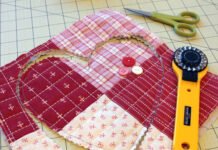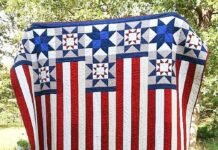The Snail’s Trail Quilt Block – Pattern is one of the most delightful and timeless patterns in the world of quilting.
Its distinctive shape, which resembles the spiral trail left behind by a snail, creates a beautiful and intriguing design.
Whether you’re a beginner or an experienced quilter, mastering this pattern is an excellent way to add a touch of creativity and fun to your quilt projects.
In this article, we will explore the Snail’s Trail Quilt Block pattern in detail, providing step-by-step instructions, tips, and tricks to help you achieve flawless results.

When approaching the Snail’s Trail pattern, it’s essential to understand its design elements. The block consists of a spiral that gradually expands outward, often using contrasting fabrics to highlight the swirls. The pattern’s versatility allows for various color combinations, giving you the freedom to create quilts that reflect your personal style and preferences. Whether you prefer a more modern or traditional aesthetic, the Snail’s Trail block adapts beautifully to different quilting projects.
In addition to its visual appeal, the Snail’s Trail Quilt Block – Pattern also offers quilters a great way to practice their skills. It incorporates techniques such as half-square triangles, quarter-square triangles, and precise piecing, which are essential in building a quilter’s repertoire. As you work through this block, you will gain valuable experience that can be applied to future quilting projects.
1. Understanding the Snail’s Trail Quilt Block Design
To start, let’s break down the basic structure of the Snail’s Trail Quilt Block – Pattern. This pattern is made up of several components, each of which contributes to the spiral effect. The core of the design is a central square, surrounded by triangles that gradually increase in size as they form a spiral outward. These triangles are often pieced together using a combination of half-square and quarter-square triangles.
One of the key aspects of the Snail’s Trail block is its ability to create a visual illusion. The way the triangles are arranged gives the appearance of a swirling spiral, drawing the eye in toward the center. This effect can be further enhanced by using high-contrast fabrics or color gradients, which create depth and movement within the quilt.
When planning your Snail’s Trail Quilt Block, it’s important to keep in mind the size of the block you want to create. Typically, the Snail’s Trail pattern can be made in various sizes, from small blocks to large ones, depending on the quilt you are working on. Regardless of the size, the spiral effect remains intact and creates a stunning focal point in your quilt.
The Snail’s Trail pattern is highly adaptable. You can experiment with different color schemes, such as using a monochromatic palette for a more subtle look or mixing bold, contrasting colors to make the spiral stand out. The layout of the pattern also offers many possibilities, including making the blocks symmetrical or offset for a more dynamic effect.
Once you understand the basic design of the Snail’s Trail Quilt Block, it’s time to start gathering your materials. You will need fabric in various colors for the triangles, as well as a solid fabric for the center square. A rotary cutter, cutting mat, and ruler will help ensure accurate measurements and precise cuts throughout the process.
Lastly, be prepared for a bit of challenge when piecing the Snail’s Trail block. While the pattern is not overly complicated, it does require accuracy in both cutting and sewing. Take your time to carefully follow the instructions and ensure each piece fits together perfectly.
2. Materials You Need for the Snail’s Trail Quilt Block
Creating the Snail’s Trail Quilt Block – Pattern requires several key materials. The quality and choice of fabric are especially important because they directly impact the overall appearance of your quilt. The right tools can make the process smoother and ensure that your quilt block turns out beautifully.
For fabric, you will need both light and dark tones to create contrast and highlight the spiral effect. Cotton fabrics are the most commonly used choice for quilting, as they are easy to work with and come in a wide variety of colors and patterns. You can choose solid colors, prints, or even batiks depending on your design preferences. Typically, you will use two or three fabrics for the Snail’s Trail block, though you can use more if you prefer a more complex look.
In addition to fabric, you will need the following quilting tools:
- Rotary Cutter: A sharp rotary cutter will help you make clean, straight cuts, essential for accurate piecing.
- Cutting Mat: This protects your work surface and provides a grid to help with measuring and cutting.
- Quilting Ruler: A ruler with grid lines ensures precise measurements and straight cuts.
- Needles and Thread: Use a good-quality quilting needle and thread in a neutral color that matches your fabric.
- Iron and Ironing Board: Pressing your seams is crucial for a polished look, so make sure you have an iron to press your fabric pieces as you go.
Having the right materials on hand makes the quilting process more enjoyable and efficient. Be sure to double-check that you have all the necessary supplies before starting the project.
3. Step-by-Step Instructions for Piecing the Snail’s Trail Quilt Block
Now that you have your materials ready, it’s time to dive into the process of creating the Snail’s Trail Quilt Block. Follow these step-by-step instructions to ensure your block turns out perfectly.
- Cut the Fabric: Start by cutting the center square, typically measuring 3.5 inches, depending on the size of the block. Next, cut the triangles for the outer layers. You’ll need to cut several squares and then cut them diagonally to create half-square triangles. For the spiral effect, you will need to create quarter-square triangles from the half-square triangles.
- Sew the Half-Square Triangles: Begin by sewing the half-square triangles together, matching the right sides of the fabric. Once they are sewn, press the seams open to reduce bulk.
- Sew the Quarter-Square Triangles: After finishing the half-square triangles, sew them together to create the quarter-square triangles. This step is essential for achieving the spiral shape that characterizes the Snail’s Trail block.
- Assemble the Block: Start assembling the block by placing the central square in the middle. Surround it with the quarter-square triangles, ensuring that they form the spiral shape. Work your way outward, adding the triangles row by row.
- Press Seams: Once the block is pieced together, press all the seams flat. This will give your Snail’s Trail Quilt Block a crisp, professional look.
- Trim the Block: Finally, trim the edges of the block to ensure it is square and the correct size for your quilt.
By following these steps carefully, you will create a stunning Snail’s Trail Quilt Block – Pattern that will be the focal point of your quilt.
4. Tips for Perfecting the Snail’s Trail Quilt Block
To achieve the best results with the Snail’s Trail Quilt Block, here are some helpful tips to keep in mind as you work through the process.
- Use Accurate Measurements: Precision is key when piecing quilt blocks. Double-check your measurements before cutting and sewing to avoid mistakes.
- Press Often: Pressing each seam as you go helps to eliminate wrinkles and ensures that your fabric lies flat, making piecing easier.
- Choose High-Quality Fabric: The better the fabric, the easier it will be to work with and the more professional your finished quilt will look. Invest in quality cotton quilting fabrics.
- Take Your Time: Quilting is an art, not a race. Take your time with each step to ensure accuracy and precision. Rushing through the process can lead to mistakes.
- Use a ¼ Inch Seam Allowance: Consistency in your seam allowance is crucial for the accuracy of your block. A ¼ inch seam allowance is standard in quilting.
- Practice Makes Perfect: If you’re new to the Snail’s Trail block, don’t be discouraged if it doesn’t turn out perfect the first time. Practice will help you improve your piecing skills over time.
FAQ
Q1: How do I make a Snail’s Trail Quilt Block larger or smaller?
A1: To adjust the size of your Snail’s Trail Quilt Block, simply scale up or down the dimensions of your fabric pieces while maintaining the proportionality of the design. For example, if you want a larger block, increase the size of the center square and the triangles accordingly.
Q2: What types of fabrics are best for the Snail’s Trail Quilt Block?
A2: Cotton fabrics are the most popular choice for quilting, including for the Snail’s Trail block. You can also use batiks, which have a beautiful texture and rich colors. Choose fabrics with contrasting colors to highlight the spiral effect.
Q3: How can I add more variety to my Snail’s Trail Quilt?
A3: You can add variety by using different color schemes, such as monochromatic tones, or by experimenting with different fabric prints. Try incorporating different patterns for each spiral or even use fabric scraps for a scrappy look.
Q4: Is the Snail’s Trail Quilt Block beginner-friendly?
A4: While the Snail’s Trail block is a bit more complex than some basic blocks, it is still beginner-friendly if you take your time and follow the instructions carefully. If you’re new to quilting, start with smaller blocks for practice.
Conclusion
The Snail’s Trail Quilt Block – Pattern is a timeless and beautiful design that adds an elegant touch to any quilt. By following the detailed instructions and tips in this article, you can master this pattern and create stunning quilt blocks that will impress anyone who sees them. Whether you’re a novice quilter or an experienced one, the Snail’s Trail pattern offers a fun challenge that will enhance your quilting skills. We’d love to hear your thoughts! Please leave a sincere opinion and any suggestions for future quilting topics.





